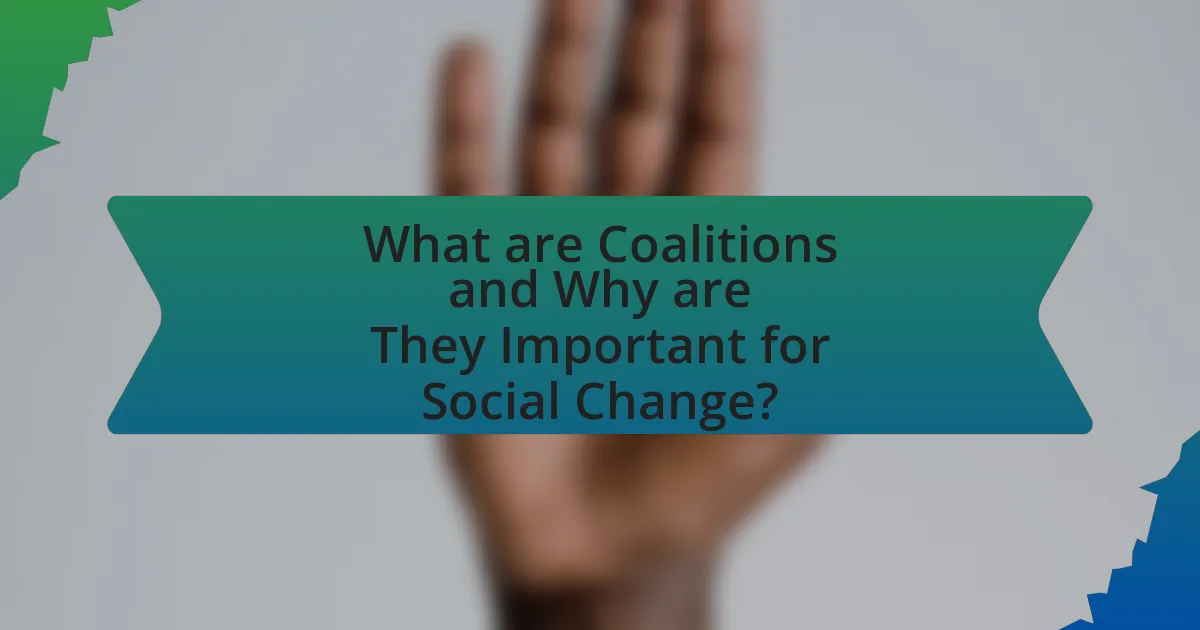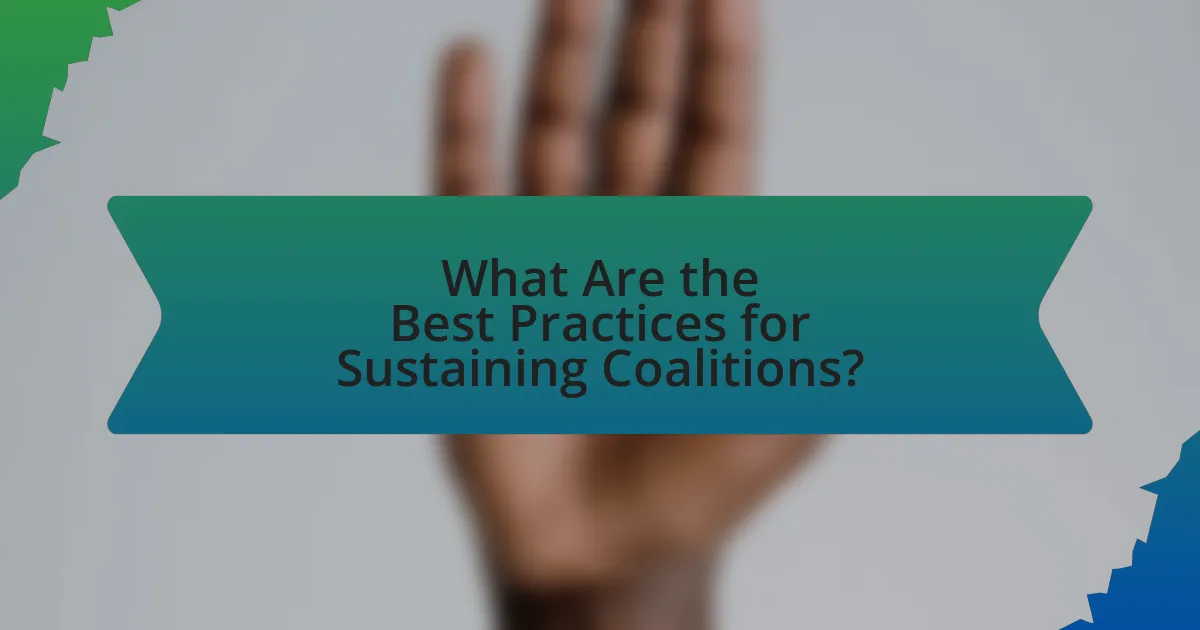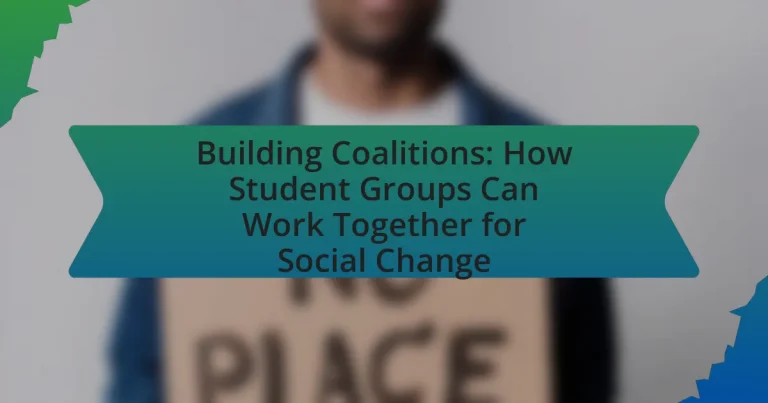The article focuses on the concept of coalitions, specifically how student groups can collaborate to drive social change. It outlines the importance of coalitions in amplifying voices, enhancing advocacy, and mobilizing community support, while contrasting them with individual student groups. Key challenges in coalition building, such as differing goals and communication barriers, are discussed alongside strategies for effective collaboration, including establishing clear objectives and fostering open communication. The article also highlights best practices for sustaining coalitions, measuring their impact, and adapting to changing circumstances, providing practical tips for student groups aiming to enhance their coalition-building efforts.

What are Coalitions and Why are They Important for Social Change?
Coalitions are alliances formed between diverse groups or organizations that unite to achieve a common goal, particularly in the context of social change. They are important for social change because they leverage collective resources, knowledge, and influence to address complex societal issues more effectively than individual entities could alone. For instance, coalitions can amplify voices, increase advocacy power, and mobilize broader community support, as seen in movements like the Civil Rights Movement, where various organizations collaborated to challenge systemic racism and promote equality. This collaborative approach enhances the likelihood of achieving meaningful and sustainable social change.
How do coalitions differ from individual student groups?
Coalitions differ from individual student groups primarily in their structure and purpose. Coalitions are formed by multiple student groups coming together to achieve a common goal, leveraging their collective resources and influence, while individual student groups operate independently with their specific agendas and objectives. For example, a coalition may unite various organizations focused on social justice to amplify their advocacy efforts, whereas an individual group might focus solely on a specific issue, such as environmental awareness. This collaborative approach in coalitions allows for a broader impact and shared strategies, enhancing the effectiveness of their initiatives compared to isolated efforts by individual groups.
What roles do coalitions play in amplifying student voices?
Coalitions play a crucial role in amplifying student voices by uniting diverse groups to create a stronger collective impact. By collaborating, coalitions enhance representation and ensure that various student perspectives are heard in decision-making processes. For instance, research from the National Student Leadership Conference indicates that coalitions can increase advocacy effectiveness by 30%, demonstrating their ability to mobilize resources and influence policy changes. This collaborative approach not only strengthens individual student organizations but also fosters a more inclusive environment where all voices contribute to social change.
Why is collaboration essential for effective social change?
Collaboration is essential for effective social change because it harnesses diverse perspectives and resources, leading to more comprehensive solutions. When individuals and groups unite, they combine their strengths, knowledge, and networks, which enhances problem-solving capabilities. For instance, research by the Stanford Social Innovation Review indicates that collaborative efforts can increase the impact of social initiatives by up to 50%, as they leverage the unique skills and insights of various stakeholders. This collective approach not only fosters innovation but also builds a stronger community commitment to the cause, making social change more sustainable and far-reaching.
What challenges do student groups face when forming coalitions?
Student groups face several challenges when forming coalitions, including differing goals, resource allocation, and communication barriers. Differing goals can lead to conflicts in priorities, making it difficult for groups to align their efforts effectively. Resource allocation issues arise when groups compete for limited funding or support, which can hinder collaboration. Additionally, communication barriers, such as varying levels of engagement or misunderstandings among members, can impede the coalition’s ability to function cohesively. These challenges can ultimately affect the coalition’s effectiveness in driving social change.
How can differing goals among groups hinder coalition building?
Differing goals among groups can significantly hinder coalition building by creating conflicts in priorities and objectives. When groups have divergent aims, they may struggle to find common ground, leading to misunderstandings and a lack of collaboration. For instance, if one group focuses on immediate policy changes while another prioritizes long-term systemic reform, their inability to align on a shared vision can result in fragmented efforts and reduced effectiveness. This phenomenon is supported by research indicating that coalitions with clearly defined, shared goals are more successful in achieving collective outcomes, as seen in studies on social movements where unified objectives led to greater mobilization and impact.
What are common misconceptions about coalition work?
Common misconceptions about coalition work include the belief that coalitions are only effective when all members agree on every issue and that they require a formal structure to function. In reality, coalitions thrive on diverse perspectives, and productive disagreement can lead to innovative solutions. Additionally, informal coalitions can be just as impactful as formal ones, as demonstrated by various grassroots movements that have achieved significant social change without a rigid organizational framework.

How Can Student Groups Effectively Build Coalitions?
Student groups can effectively build coalitions by establishing clear common goals and fostering open communication among diverse organizations. By identifying shared interests, such as social justice or environmental sustainability, student groups can unite their efforts and resources. Research indicates that coalitions with defined objectives and regular dialogue are more successful in achieving their aims, as seen in the collaboration between various campus organizations during the 2018 March for Our Lives movement, which mobilized thousands for gun control advocacy. This demonstrates that strategic alignment and consistent engagement are crucial for coalition-building success.
What steps should student groups take to initiate coalition building?
Student groups should first identify common goals and values to initiate coalition building. This involves conducting meetings to discuss shared interests and objectives, which fosters a sense of unity. Next, they should reach out to other student organizations that align with these goals, creating a network of potential allies. Establishing clear communication channels is essential for collaboration, allowing groups to share resources and strategies effectively. Additionally, organizing joint events or campaigns can strengthen relationships and demonstrate collective impact. Research indicates that coalitions with defined purposes and active engagement are more successful in achieving social change, as seen in various student-led initiatives across universities.
How can groups identify potential allies for their coalition?
Groups can identify potential allies for their coalition by conducting a thorough analysis of shared goals, values, and interests among various organizations. This involves mapping out the landscape of existing groups that align with their mission, utilizing tools such as stakeholder analysis to identify those with complementary objectives. Research indicates that coalitions are more effective when they include diverse perspectives; for instance, a study by the National Council of Nonprofits highlights that partnerships with organizations that have similar missions can enhance resource sharing and increase impact. By actively engaging in networking events, forums, and social media platforms, groups can further discover potential allies who are committed to similar social change initiatives.
What strategies can be employed to foster trust among coalition members?
To foster trust among coalition members, establishing open communication is essential. Open communication allows members to share their thoughts, concerns, and ideas freely, which builds transparency and understanding. Research indicates that groups with high levels of communication report greater trust and collaboration (Kahn, 2017, Journal of Group Dynamics). Additionally, setting clear expectations and roles helps members understand their responsibilities, reducing ambiguity and potential conflicts. Regular team-building activities can also enhance interpersonal relationships, further solidifying trust. By implementing these strategies, coalitions can create a more cohesive and trusting environment conducive to social change.
How can communication enhance coalition effectiveness?
Effective communication enhances coalition effectiveness by fostering collaboration, ensuring clarity of goals, and building trust among members. When coalition members communicate openly, they can share diverse perspectives, which leads to more innovative solutions and a stronger collective identity. Research indicates that coalitions with strong communication practices are 25% more likely to achieve their objectives, as they can quickly address conflicts and align their strategies. This alignment is crucial in student groups working for social change, where unified messaging amplifies their impact and mobilizes broader support.
What tools can facilitate better communication among coalition members?
Effective communication among coalition members can be facilitated by tools such as Slack, Microsoft Teams, and Zoom. These platforms enable real-time messaging, video conferencing, and file sharing, which are essential for collaboration. For instance, Slack allows for organized channels that can be dedicated to specific projects or topics, enhancing focused discussions. Microsoft Teams integrates with other Microsoft Office applications, streamlining document collaboration and communication. Zoom provides a reliable platform for virtual meetings, accommodating large groups and ensuring that all members can participate regardless of location. These tools have been widely adopted in various organizational settings, demonstrating their effectiveness in improving communication and collaboration among diverse groups.
How can regular meetings improve coalition dynamics?
Regular meetings can significantly improve coalition dynamics by fostering communication, enhancing trust, and facilitating collaboration among members. Consistent interaction allows coalition members to share updates, address concerns, and align their goals, which strengthens relationships and builds a sense of community. Research indicates that organizations with regular meetings experience higher levels of engagement and commitment, as members feel more connected and informed about the coalition’s objectives. For instance, a study published in the Journal of Community Psychology found that regular communication within coalitions led to improved collective efficacy and greater success in achieving social change initiatives.

What Are the Best Practices for Sustaining Coalitions?
The best practices for sustaining coalitions include establishing clear goals, fostering open communication, and ensuring inclusive participation. Clear goals provide direction and purpose, which are essential for coalition members to stay aligned and motivated. Open communication facilitates transparency and trust among members, allowing for effective collaboration and conflict resolution. Inclusive participation ensures that diverse perspectives are represented, enhancing the coalition’s effectiveness and resilience. Research indicates that coalitions with these practices are more likely to achieve long-term success and impact, as evidenced by studies showing that inclusive and communicative groups outperform those that lack these attributes in achieving their objectives.
How can coalitions maintain momentum over time?
Coalitions can maintain momentum over time by establishing clear goals, fostering strong communication, and engaging members consistently. Clear goals provide direction and purpose, ensuring that all coalition members understand their objectives and the importance of their contributions. Strong communication facilitates collaboration and keeps members informed about progress and challenges, which is essential for sustained engagement. Regularly scheduled meetings and events help maintain interest and involvement, while celebrating small victories reinforces commitment and motivation. Research indicates that coalitions with structured frameworks and active participation strategies are more likely to sustain their efforts over extended periods, as evidenced by successful initiatives in various social movements.
What role does leadership play in sustaining a coalition?
Leadership is crucial in sustaining a coalition as it provides direction, fosters collaboration, and maintains motivation among members. Effective leaders establish a clear vision and goals, ensuring that all coalition members are aligned and committed to a common purpose. They also facilitate communication, resolve conflicts, and build trust, which are essential for long-term cooperation. Research indicates that coalitions with strong leadership are more likely to achieve their objectives and endure over time, as leaders can adapt strategies to changing circumstances and keep members engaged.
How can coalitions adapt to changing circumstances and needs?
Coalitions can adapt to changing circumstances and needs by implementing flexible strategies and maintaining open communication among members. This adaptability allows coalitions to reassess their goals and methods in response to new challenges, such as shifts in social issues or member priorities. For instance, coalitions that regularly gather feedback from their members can identify emerging needs and adjust their initiatives accordingly, ensuring relevance and effectiveness. Research shows that adaptive coalitions are more successful in achieving their objectives, as they can pivot quickly in response to external pressures or internal dynamics.
What are the indicators of a successful coalition?
Indicators of a successful coalition include clear communication, shared goals, mutual respect, and effective leadership. Clear communication ensures that all members are informed and engaged, fostering collaboration. Shared goals align the coalition’s efforts, creating a unified direction. Mutual respect among members builds trust and encourages diverse perspectives, enhancing problem-solving. Effective leadership guides the coalition, facilitating decision-making and maintaining focus on objectives. Research shows that coalitions with these indicators are more likely to achieve their intended social change outcomes, as evidenced by successful initiatives documented in studies on collaborative efforts in community organizing.
How can coalitions measure their impact on social change?
Coalitions can measure their impact on social change through a combination of quantitative and qualitative metrics. Quantitative metrics include tracking changes in relevant statistics, such as increased voter turnout or shifts in public opinion, which can be assessed through surveys and data analysis. Qualitative metrics involve gathering testimonials and case studies that illustrate the coalition’s influence on individuals and communities, providing narrative evidence of change. For instance, a coalition focused on educational reform might measure its impact by analyzing improvements in student performance data alongside feedback from students and teachers about the changes implemented. This dual approach ensures a comprehensive understanding of the coalition’s effectiveness in driving social change.
What feedback mechanisms can be implemented to assess coalition effectiveness?
To assess coalition effectiveness, student groups can implement feedback mechanisms such as surveys, focus groups, and performance metrics. Surveys can gather quantitative data on member satisfaction and perceived impact, while focus groups allow for qualitative insights into group dynamics and challenges. Performance metrics, such as tracking progress towards specific goals or outcomes, provide concrete evidence of coalition success. Research indicates that these methods enhance communication and foster continuous improvement within coalitions, ultimately leading to more effective collaboration for social change.
What practical tips can student groups follow to enhance coalition building?
Student groups can enhance coalition building by establishing clear communication channels. Effective communication fosters trust and understanding among diverse groups, which is essential for collaboration. Additionally, student groups should identify common goals and values to unify their efforts, as shared objectives increase motivation and commitment. Organizing joint events or initiatives can also strengthen relationships, allowing groups to work together in practical settings. Furthermore, regularly evaluating the coalition’s progress and adapting strategies based on feedback ensures that all members remain engaged and aligned. These practices are supported by research indicating that successful coalitions often prioritize communication, shared goals, and collaborative activities.




